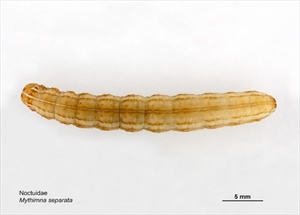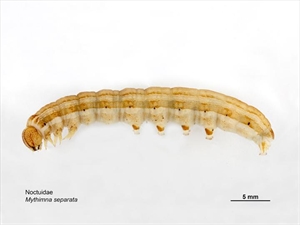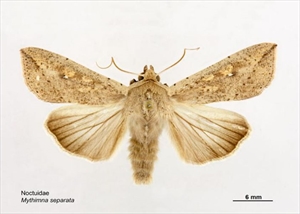- Widespread distribution. On rice and many other cereals, vegetables, food legumes, grass weeds. Important moth, more so on dryland than irrigated rice.
- Damage: i) rice - panicles cut at base at grain filling; ii) maize - young plants destroyed; mature leaves eaten (larvae in axils).
- Eggs laid in rows along leaf blades; young larvae "loop"; mature larvae, up to 40 mm long, with narrow, yellowish-white stripe along the back and two others at the sides; nocturnal.
- Spread: late stage larvae swarm together as "armyworms"; adult (moth) migratory.
- Natural enemies: spiders eat early instars; parasitoids (Cortesia wasp, tachnid fly).
- Cultural control: avoid rice after maize; weed; ducks; perches for insect-feeding birds; adjust water levels to drown larvae; burn or bury stubble after harvest.
- Chemical control: dryland crops before larvae mature: i) collect diseased larvae, macerate and spray; ii) synthetic pyrethroids, but they will kill natural enemies.
Pacific Pests, Pathogens and Weeds - Online edition
Pacific Pests, Pathogens, Weeds & Pesticides
Rice (maize) armyworm (331)
Paddy armyworm, rice armyworm, oriental armyworm, rice ear-cutting caterpillar.
Mythimna separata; previously known as Pseudoaletia separata. It is a member of the Noctuidae.
AUTHOR Grahame Jackson
Information from CABI (2015) Mythimna separata (paddy armyworm) Crop Protection Compendium (https://www.cabi.org/cpc/datasheet/45093); and from Paddy armyworm (Mythimna separata) Plantwise Knowledge Bank (http://www.plantwise.org/KnowledgeBank/Datasheet.aspx?dsid=45093); and from Catindig J (undated) Armyworm. Rice Knowledge Bank. IRRI.(http://www.knowledgebank.irri.org/training/fact-sheets/pest-management/insects/item/armyworms). Photo 1 Gross L (2006) Plants tell caterpillars when it's safe to forage. PLoS Biol 4(6): e194. (https://doi.org/10.1371/journal.pbio.0040194). Photos 2-5 MAF Plant Health & Environment Laboratory (2011) Oriental armyworm (Mythimna separata) PaDIL - (http://www.padil.gov.au).
Produced with support from the Australian Centre for International Agricultural Research under project PC/2010/090: Strengthening integrated crop management research in the Pacific Islands in support of sustainable intensification of high-value crop production, implemented by the University of Queensland and the Secretariat of the Pacific Community.








